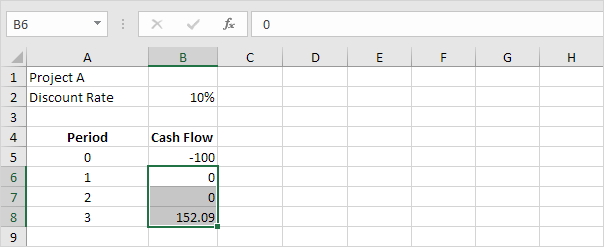How do you use the IRR function in Excel?
To instruct the Excel program to calculate IRR, type in the function command “=IRR(A1:A4)” into the A5 cell directly under all the values.
When you hit the enter key, the IRR value, 8.2%, should be displayed in that cell.
Microsoft Excel uses an iterative technique for calculating IRR. Starting with guess, IRR cycles through the calculation until the result is accurate within 0.00001 percent. If IRR can't find a result that works after 20 tries, the #NUM! Error value is returned. In most cases you do not need to provide guess for the IRR. Microsoft Excel uses an iterative technique for calculating IRR. Starting with guess, IRR cycles through the calculation until the result is accurate within 0.00001 percent. If IRR can't find a result that works after 20 tries, the #NUM! Error value is returned. In most cases you do not need to provide guess for the IRR calculation. We can use IRR (Internal Rate of Return) function in Excel to calculate return from a series of even spaced cash flows. IRR Example: For example, say you invest $10,000 in a savings bond and you get $500 per year for next 5 years and then you will get $11,000 back. The XIRR function calculates in the internal rate of return for series of cash flows that occur at irregular intervals. To calculate the internal rate of return for a series of regular, periodic cash flows, use the IRR function. Payments are expressed as negative values and income as positive values. 2) Using Excel’s IRR Function This is an easy and straightforward way of calculating YTM in Excel. You see I have just entered the future cash flows from the bond investments in a column (Payment column) and then used Excel’s IRR function. The formula gives us the internal rate of return for a period: 3.75%.
Why is IRR not working in Excel?
The Problem: Even if net cashflows are negative, Excel can produce a positive IRR. For example, if cashflows at the beginning of a project are small and positive, and at the end of the project are large and negative, the IRR will necessarily need to be high to reduce the net present value of the later cashflows.
What is the formula for IRR?
To calculate IRR using the formula, one would set NPV equal to zero and solve for the discount rate (r), which is the IRR. Because of the nature of the formula, however, IRR cannot be calculated analytically and must instead be calculated either through trial-and-error or using software programmed to calculate IRR.
How do you calculate IRR and NPV in Excel?
Using Excel to calculate NPV and IRR –
How do you calculate IRR quickly?
To calculate IRR using the formula, one would set NPV equal to zero and solve for the discount rate (r), which is the IRR. Because of the nature of the formula, however, IRR cannot be calculated analytically and must instead be calculated either through trial-and-error or using software programmed to calculate IRR.

What is a good IRR?
Typically expressed in a percent range (i.e. 12%-15%), the IRR is the annualized rate of earnings on an investment. A less shrewd investor would be satisfied by following the general rule of thumb that the higher the IRR, the higher the return; the lower the IRR the lower the risk.
Can you have an IRR greater than 100?
Keep in mind that an IRR greater than 100% is possible. Extra credit if you can also correctly handle input that produces negative rates, disregarding the fact that they make no sense. You pick an IRR and check to see if the NPV is zero, or very close to it. When it is, you found the right IRR.
How does Excel IRR work?
Irr Excel Template
The Microsoft Excel IRR function returns the internal rate of return for a series of cash flows. The cash flows must occur at regular intervals, but do not have to be the same amounts for each interval. The IRR function is a built-in function in Excel that is categorized as a Financial Function.
Can IRR be positive if NPV negative?
If your IRR < Cost of Capital, you still have positive IRR but negative NPV. Instead, if your cost of capital is 15%, then your IRR will be 10% but NPV shall be negative. So, you can have positive IRR despite negative NPV.
How do you calculate IRR on a calculator?
Internal Rate of Return IRR with TI 84 –
What is the difference between IRR and ROI?
IRR vs ROI Key Differences
One of the key differences between ROI vs IRR is the time period for which they are used for calculating the performance of investments. IRR is used to calculate the annual growth rate of the investment made. Whereas, ROI doesn’t take future value of money while doing the calculations.
How do I calculate IRR using Excel?
To instruct the Excel program to calculate IRR, type in the function command “=IRR(A1:A4)” into the A5 cell directly under all the values. When you hit the enter key, the IRR value, 8.2%, should be displayed in that cell.
How do you calculate multiple IRR?
How To Work Out Irr In Excel

How Does Irr Work In Excel
Cash flow with multiple IRRs –
How do you calculate NPV and IRR?
NPV and IRR explained –
What is NPV and IRR?
Using Irr Function In Excel
Net present value (NPV) is the difference between the present value of cash inflows and the present value of cash outflows over a period of time. By contrast, the internal rate of return (IRR) is a calculation used to estimate the profitability of potential investments.